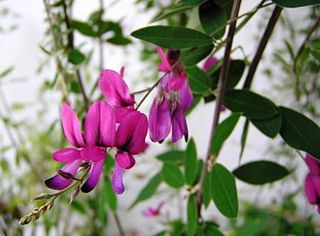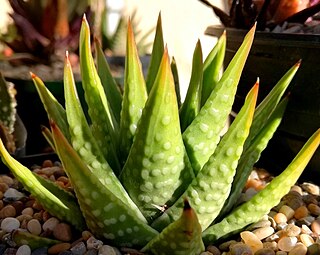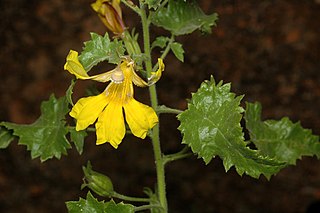
The Faboideae are a subfamily of the flowering plant family Fabaceae or Leguminosae. An acceptable alternative name for the subfamily is Papilionoideae, or Papilionaceae when this group of plants is treated as a family.

Dalbergia is a large genus of small to medium-size trees, shrubs and lianas in the pea family, Fabaceae, subfamily Faboideae. It was recently assigned to the informal monophyletic Dalbergia clade : the Dalbergieae. The genus has a wide distribution, native to the tropical regions of Central and South America, Africa, Madagascar and southern Asia.

Vigna is a genus of plants in the legume family, Fabaceae, with a pantropical distribution. It includes some well-known cultivated species, including many types of beans. Some are former members of the genus Phaseolus. According to Hortus Third, Vigna differs from Phaseolus in biochemistry and pollen structure, and in details of the style and stipules.

Lespedeza is a genus of some 45 species of flowering plants in the pea family (Fabaceae), commonly known as bush clovers or Japanese clovers (hagi). The genus is native to warm temperate to subtropical regions of eastern North America, eastern and southern Asia and Australasia.

Coriaria is the sole genus in the family Coriariaceae, which was described by Linnaeus in 1753. It includes 14 species of small trees, shrubs and subshrubs, with a widespread but disjunct distribution across warm temperate regions of the world, occurring as far apart as the Mediterranean region, southern and eastern Asia, New Zealand, the Pacific Ocean islands, and Central and South America.

Sir David Prain was a Scottish botanist who worked in India at the Calcutta Botanical Garden and went on to become Director of the Royal Botanic Gardens, Kew.
Leslie Pedley was an Australian botanist who specialised in the genus Acacia. He is notable for bringing into use the generic name Racosperma, creating a split in the genus, which required some 900 Australian species to be renamed, because the type species of Acacia, Acacia nilotica, now Vachellia nilotica, had a different lineage from the Australian wattles. However, the International Botanical Congress (IBC), held in Melbourne in 2011, ratified its earlier decision to retain the name Acacia for the Australian species, but to rename the African species.
Nothaphoebe kingiana is a species of plant in the family Lauraceae. It is native to Peninsular Malaysia and Borneo.

Hylodesmum is a genus of flowering plants in the family Fabaceae, sometimes called ticktrefoils or tick-trefoils. It is sometimes treated as part of Desmodium. It includes 16 species native to eastern North America, sub-Saharan Africa, Yemen, south, southeast, and eastern Asia, Malesia, and New Guinea.
Tadehagi is a genus of flowering plants in the legume family, Fabaceae. It includes six species of subshrubs and shrubs native to the Indian subcontinent, Indochina, southern China, the Philippines, New Guinea, and Western Australia. Five of the six species are native to India and Indochina, and one is endemic to Western Australia. Typical habitats include seasonally-dry tropical and subtropical forest, scrub, and grassland, including rocky and riparian areas. It belongs to the subfamily Faboideae.
Hiroyoshi Ohashi is a botanist formerly at the University of Tokyo and Tohoku University. He began publishing on Japanese Arisaema in the early 1960s. He published a couple of miscellaneous notes on Arisaema in 1963 and 1964 and these were followed by a revision of the genus for Japan jointly published in 1980 with J. Murata, and by the Araceae treatment for the Wildflowers of Japan.

Bistorta is a genus of flowering plants in the family Polygonaceae. As of February 2019 about 40 species are accepted. It has been supported as a separate clade by molecular phylogenetic analysis. Bistorta species are native throughout much of the Northern Hemisphere, as far south as Mexico in North America and Thailand in Asia.
Madhuca kingiana is a tree in the family Sapotaceae. It is named for the botanist George King.

Tulista is a small genus of succulent plants endemic to the Cape Provinces of South Africa. They were formerly included within the genus Haworthia.

Tulista kingiana is a species of succulent plant, from the Western Cape, South Africa. It is listed as Endangered on the IUCN global Red List.

Hylodesmum glutinosum is a species of flowering plant in the family Fabaceae. Common names include large tick-trefoil, clustered-leaved tick-trefoil, large-flowered tick-clover, pointed tick-trefoil, beggar's lice and pointed-leaved tick-trefoil. It occurs in eastern Canada, the central and eastern United States, and northeastern Mexico.

Ototropis is a genus of flowering plants in the family Fabaceae, found from Afghanistan, the Indian Subcontinent through to southern China including Taiwan, Southeast Asia, Indonesia and on to New Guinea, and introduced to Japan. There has been some nomenclatural confusion regarding this taxon over the centuries.

Goodenia kingiana is a species of flowering plant in the family Goodeniaceae and is endemic to Western Australia. It is an erect shrub with deeply-lobed or divided leaves and racemes or thyrses of yellow flowers.
Croninia is a genus of flowering plants belonging to the family Ericaceae.
Pseuduvaria kingiana is a species of plant in the family Annonaceae. It is native to the Malay Peninsula. Yvonne Chuan Fang Su and Richard Saunders, the botanists who first formally described the species, named it after Sir George King, the British botanist who first collected the species.












